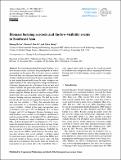Biomass burning aerosols and the low-visibility events in Southeast Asia
Author(s)
Lee, Hsiang-He; Bar Or, Rotem Zvi; Wang, Chien
DownloadLee-2017-Biomass burning aerosols and the low-.pdf (3.894Mb)
PUBLISHER_CC
Publisher with Creative Commons License
Creative Commons Attribution
Terms of use
Metadata
Show full item recordAbstract
Fires including peatland burning in Southeast Asia have become a major concern to the general public as well as governments in the region. This is because aerosols emitted from such fires can cause persistent haze events under certain weather conditions in downwind locations, degrading visibility and causing human health issues. In order to improve our understanding of the spatiotemporal coverage and influence of biomass burning aerosols in Southeast Asia, we have used surface visibility and particulate matter concentration observations, supplemented by decade-long (2003 to 2014) simulations using the Weather Research and Forecasting (WRF) model with a fire aerosol module, driven by high-resolution biomass burning emission inventories. We find that in the past decade, fire aerosols are responsible for nearly all events with very low visibility (< 7 km). Fire aerosols alone are also responsible for a substantial fraction of low-visibility events (visibility < 10 km) in the major metropolitan areas of Southeast Asia: up to 39 % in Bangkok, 36 % in Kuala Lumpur, and 34 % in Singapore. Biomass burning in mainland Southeast Asia accounts for the largest contribution to total fire-produced PM[subscript 2.5] in Bangkok (99 %), while biomass burning in Sumatra is a major contributor to fire-produced PM[subscript 2.5] in Kuala Lumpur (50 %) and Singapore (41 %). To examine the general situation across the region, we have further defined and derived a new integrated metric for 50 cities of the Association of Southeast Asian Nations (ASEAN): the haze exposure day (HED), which measures the annual exposure days of these cities to low visibility (< 10 km) caused by particulate matter pollution. It is shown that HEDs have increased steadily in the past decade across cities with both high and low populations. Fire events alone are found to be responsible for up to about half of the total HEDs. Our results suggest that in order to improve the overall air quality in Southeast Asia, mitigation policies targeting both biomass burning and fossil fuel burning sources need to be implemented.
Date issued
2017-01Department
Massachusetts Institute of Technology. Center for Global Change ScienceJournal
Atmospheric Chemistry and Physics
Publisher
Copernicus GmbH
Citation
Lee, Hsiang-He, Rotem Z. Bar-Or, and Chien Wang. “Biomass Burning Aerosols and the Low-Visibility Events in Southeast Asia.” Atmospheric Chemistry and Physics 17.2 (2017): 965–980.
Version: Final published version
ISSN
1680-7324